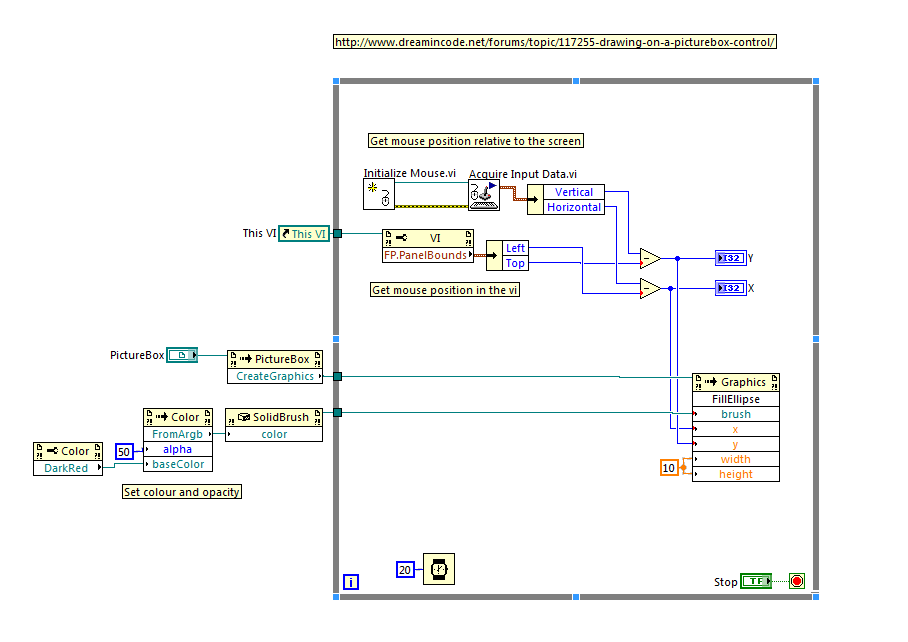-
Posts
1,198 -
Joined
-
Last visited
-
Days Won
112
Content Type
Profiles
Forums
Downloads
Gallery
Everything posted by Neil Pate
-
How big are the images you are writing to disk? I would have thought that the bottleneck in most systems would be the speed of physically writing to disk, not the passing around of the data in the software. Modern CPUs/RAM can shovel ridiculous quantities of data around if the software is architectured properly.
-
Dequeue with -1 timeout should use virtually zero of your CPU resources. You can rely on this mechanism on RT the same as your do on the PC. RT-FIFOs do have the option where read and writes are polling (using CPU) or blocking (CPU sleeping), but as you state you are using queues and not RT-FIFOs then this does not apply to your application. Is it possible that perhaps something else is going on that periodically causes a big CPU spike? If it is a quick event you may not notice it in your CPU profiling code, but some other bit of code may be affected. The other culprit could be timed loops. Are you using any?
-
This is good to know about. I use Ultramon so am surprised I have never seen this issue. As you said in the other thread hooovahh, I do not know how people manage to develop large applications in LabVIEW without tremendous quantities of display pixels. The more the merrier for me these days. I have a 19" vertically oriented monitor on the left dedicated to any open .lvproj windows, a 27" to the right of that (so in the middle), and another 19" to the right of that and still wish I had more space at times!
-
Totally agree with you, but... Very very small probably if you set the CWD immediately before calling the DLL function. I suppose deciding whether to use this function or not depends an awful lot on the risk of something going wrong combined with the likelihood of it happening.
- 8 replies
-
- side by side configuration
- dll
- (and 3 more)
-
To follow on from what Rolf said, you can programatically set the current directory using the Win32 API. This is often convenient if you know your DLL is in a certain place. I did use this technique many years ago, but have not needed it since. To get an idea on how to do this look at the attached VI (obtained here). Set Current Directory.vi
- 8 replies
-
- side by side configuration
- dll
- (and 3 more)
-

how to read word documents into my labview?
Neil Pate replied to seoul's topic in Calling External Code
Bingo! 9 months later... -

Web Services and Proxy Servers
Neil Pate replied to Neil Pate's topic in Remote Control, Monitoring and the Internet
Hi Rolf. I have cherry picked some of the good bits out of your library and put together a very simple application that uses the TCP prims (rather than the NI HTTP library) to do my Web Service query. It works fine from my PC (no proxy server), so now I need to wait and see if it works for my client. Thanks! -

Web Services and Proxy Servers
Neil Pate replied to Neil Pate's topic in Remote Control, Monitoring and the Internet
Cool! I will take a look at this a bit later today. Thanks for your help -

Web Services and Proxy Servers
Neil Pate replied to Neil Pate's topic in Remote Control, Monitoring and the Internet
Thanks for the insight Shaun. I do recall seeing Rolf's HTTP VIs, and this is what in fact lead me to believe I could just prepend the proxy, but probably I just misunderstood. I don't really know enough about this stuff so I guess it is time to learn something! -
Hi All, I have an application which uses a Web Service to talk to a LabVIEW based server, somewhere on the internet. The application works very well under normal circumstances, but I am having some trouble getting any comms through for one particular customer. The difference for this customer is that I know they use a proxy server for all web traffic. I have not had much exposure to proxy servers, but my understanding is that if I just prepend the proxy server IP address (or name) to the "address" of any http type requests everything should work fine. So in other words, if I normally call http://mywebservice/testmethod then to get this to work with a proxy server I would just need to re-direct my request to http://myproxyserver/mywebservice/testmethod Is this correct? If so there must be something else going on as I have tried this and still cannot get any comms going. The IT guy I am working with says none of the requests even get to the proxy server. Has anybody done any work with Web Services and proxy servers?
-

Using sample projects for the CLED Exam
Neil Pate replied to LewisG's topic in Certification and Training
Definitely have to disagree with you here. depends... do they want something quick and dirty that will help them right now, or something with more thought (and probably neater) that will probably serve them better in the long run. Different clients have different requirements. Anyway. I am not really moaning or anything. If I fail it due to missing functionality then next time I just better not take the five pee breaks I needed this time around -
You can get the Inno setup to execute another application as part of the setup, in the example pasted below I execute the RTE setup exe. Note I have manually extracted the RTE so that it consists of its bits and pieces. You also have to tell Inno to include the files in the setup (that is the [Files] section) [Files] Source: "C:YOURPROJECTNAMEResourcesInstallerLVRTE_Extracted*"; DestDir: "{tmp}LVRTE_Extracted"; Flags: recursesubdirs createallsubdirs [Run] Filename: "{tmp}LVRTE_Extractedsetup.exe"; Parameters: "/q /AcceptLicenses yes /r /disableNotificationCheck"; WorkingDir: "{tmp}LVRTE_extracted"; Flags: waituntilterminated; StatusMsg: "Installing LabVIEW Run-Time Engine"
-

Using sample projects for the CLED Exam
Neil Pate replied to LewisG's topic in Certification and Training
I think perhaps the design, style and documentation should be worth more. I have a pretty high level of coding standard (i.e. block diagram neatness, comments etc) that I always try and aim for. This is ingrained in me after more than 15000 hours of doing LabVIEW. As such, it is very difficult to override this instinct and code "messily" just to try and get all the functionality in. -
Does anybody know of a good way to find out the latest runtime engine that can be downloaded from ni.com? What I mean is a permanent link to a page with the latest version listed only? i.e. just show the latest runtime for Windows/Mac/Linux I know that ni.com/src does have a list of all the software, but it can be tricky to find what you actually want.
-

Using sample projects for the CLED Exam
Neil Pate replied to LewisG's topic in Certification and Training
Like Lewis I also took the exam today, however I chose not to use the sample templates. Same result though, I and also ran out of time -
Glad that helped you. I also prefer the fact that it creates a single setup.exe file, rather than the way the NI installer creation creations (I think) .msi Inno setup makes it quite easy to run other things as well as part of the setup, so you can install (for example) .net or the LabVIEW runtime etc.
-
Mike, not sure if this will help you, but if you add NI_Appbuilder_logging=TRUE to your LabVIEW.ini file then you will get a comprehensive build log for your .exes and installers. If your installer is failing to build just scroll down to the last line and see if there is a more verbose error message there. The log file is in the same directory as the .lvproj
-

Using sample projects for the CLED Exam
Neil Pate replied to LewisG's topic in Certification and Training
Hi Lewis, I am also taking my CLED next Tuesday (you taking yours in Newbury, right?) and will probably not be using the sample projects, although I may borrow bits and pieces. You are probably right in that the exam will be quite a close match to the sample project, but I think you would have to spend too much time modifying it to meet the new requirements. -

Create pictures with different opacity levels
Neil Pate replied to GregPayne's topic in Machine Vision and Imaging
It would be nice if all of the VIs in the NI_WebServices.lvlib were not password protected. -

Create pictures with different opacity levels
Neil Pate replied to GregPayne's topic in Machine Vision and Imaging
Greg, I do not have 2010 installed either, but here is a picture maybe you can recreate it from this? -

Create pictures with different opacity levels
Neil Pate replied to GregPayne's topic in Machine Vision and Imaging
Looks neat. Am going to tinker with this .net control too if I get a chance. Just a heads up, I know this was just a proof of concept, but you probably don't want to be creating all those objects inside the loop.




